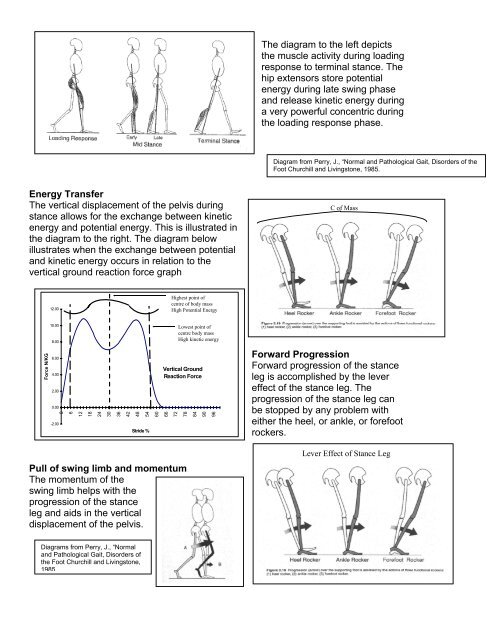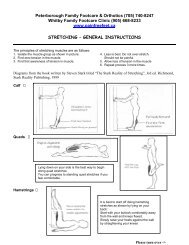Gait Analysis Handout - painfreefeet.ca
Gait Analysis Handout - painfreefeet.ca
Gait Analysis Handout - painfreefeet.ca
Create successful ePaper yourself
Turn your PDF publications into a flip-book with our unique Google optimized e-Paper software.
Energy Transfer<br />
The verti<strong>ca</strong>l displacement of the pelvis during<br />
stance allows for the exchange between kinetic<br />
energy and potential energy. This is illustrated in<br />
the diagram to the right. The diagram below<br />
illustrates when the exchange between potential<br />
and kinetic energy occurs in relation to the<br />
verti<strong>ca</strong>l ground reaction force graph<br />
Force N/KG<br />
12.00<br />
10.00<br />
8.00<br />
6.00<br />
4.00<br />
2.00<br />
0.00<br />
-2.00<br />
Verti<strong>ca</strong>l Ground<br />
Reaction Force<br />
0<br />
6<br />
12<br />
18<br />
24<br />
30<br />
36<br />
42<br />
48<br />
54<br />
60<br />
66<br />
72<br />
78<br />
84<br />
90<br />
96<br />
Stride %<br />
Pull of swing limb and momentum<br />
The momentum of the<br />
swing limb helps with the<br />
progression of the stance<br />
leg and aids in the verti<strong>ca</strong>l<br />
displacement of the pelvis.<br />
Diagrams from Perry, J., “Normal<br />
and Pathologi<strong>ca</strong>l <strong>Gait</strong>, Disorders of<br />
the Foot Churchill and Livingstone,<br />
1985<br />
Highest point of<br />
centre of body mass<br />
High Potential Energy<br />
Lowest point of<br />
centre body mass<br />
High kinetic energy<br />
The diagram to the left depicts<br />
the muscle activity during loading<br />
response to terminal stance. The<br />
hip extensors store potential<br />
energy during late swing phase<br />
and release kinetic energy during<br />
a very powerful concentric during<br />
the loading response phase.<br />
Diagram from Perry, J., “Normal and Pathologi<strong>ca</strong>l <strong>Gait</strong>, Disorders of the<br />
Foot Churchill and Livingstone, 1985.<br />
C of Mass<br />
Forward Progression<br />
Forward progression of the stance<br />
leg is accomplished by the lever<br />
effect of the stance leg. The<br />
progression of the stance leg <strong>ca</strong>n<br />
be stopped by any problem with<br />
either the heel, or ankle, or forefoot<br />
rockers.<br />
Lever Effect of Stance Leg



